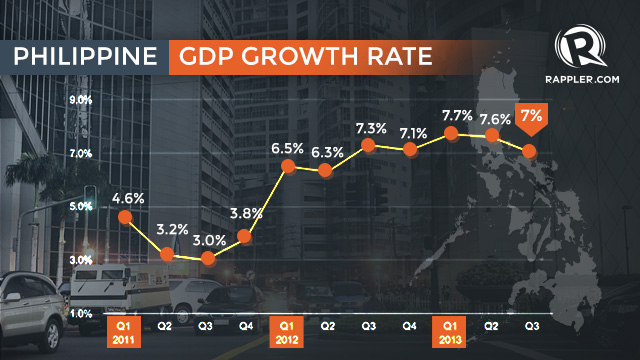SUMMARY
This is AI generated summarization, which may have errors. For context, always refer to the full article.

MANILA, Philippines – The Philippine economy should grow 7% this year and between 6.5% and 7.5% next year despite the devastation caused by a killer typhoon and an earthquake, the government said Tuesday, December 17.
Economic planning minister Arsenio Balisacan said that while losses in agriculture caused by Super Typhoon Yolanda (Haiyan) in November were expected to hit growth in the near term, rebuilding would likely make up for it further down the line.
He said 2013 gross domestic product (GDP) growth should hit the “upper limit” of the government’s 6%-7% target, forecasts first made before Haiyan hit last month and a 7.1-magnitude quake struck some of the country’s main tourist regions in October.
“Without all these crises, we could have achieved 7.3 to 7.5% growth this year,” Balisacan said in a statement.
Nevertheless, he added that the Philippines should continue its hot streak of 5 consecutive quarters of at least 7% growth.
“For 2014, we forecast growth to be in the 6.5-7.5 percent range.”
Haiyan killed 6,069 people when it struck the centre of the country last month, while also destroying more than a million homes, displacing four million people.
A total of 1,779 others are still missing, according to a government tally.
President Benigno Aquino has said rebuilding dozens of towns and cities, some of which were obliterated by tsunami-like storm surges brought by Haiyan, would require nearly $3 billion of government spending.
Balisacan said Manila would shortly unveil a reconstruction plan for areas hit by Haiyan.
“The intention mainly is to restore the economic and social conditions of these areas at the very least to their pre-typhoon levels and to a higher level of disaster resilience,” he added.
Despite the period of high growth, Balisacan acknowledged that the government had yet to make a significant dent on widespread poverty and joblessness.
About 25.2% of the population were considered poor last year, almost unchanged from 26.3% in 2011, according to government data.
And the unemployment rate stood at 6.5% in October, on top of 17.9% of the labor force that were considered underemployed.
“These twin problems of poverty and unemployment require more than just five quarters of impressive economic growth,” Balisacan said.
“Structural transformation is necessary, that is, to manoeuvre the economy from one that is household consumption-driven… to one that is increasingly investment-led and employment-oriented.” – Rappler.com
Add a comment
How does this make you feel?
There are no comments yet. Add your comment to start the conversation.